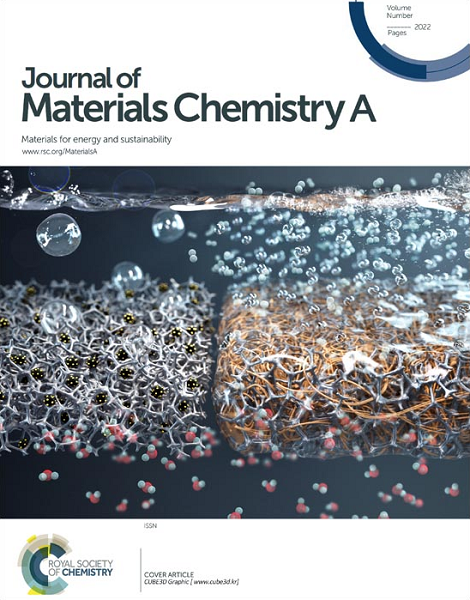Co(II) Complex Promoted PVDF β-Phase Crystallization: Innovations in Pressure Sensing and Energy Harvesting
IF 10.7
2区 材料科学
Q1 CHEMISTRY, PHYSICAL
引用次数: 0
Abstract
The development of self-powered piezoelectric nanogenerators (PENG) using conventional bulk oxides has been hindered by several issues, including heavy metal toxicity, limited flexibility, and complex synthetic processes. These challenges can potentially be addressed by employing discrete molecular-based metal complexes. However, research in this area remains limited due to the difficulties in controlling non-centrosymmetric point/ space groups. In this manuscript, we present a Co(II) complex with the molecular formula [Co(bpy)3] (PF6)2 (referred as Co-bpy hereafter; where bpy = bipyridine), which crystallizes in the polar P31 space group. A flexible PENG device was fabricated using a PVDF composite containing various weight/volume % of Co-bpy (3% (PVH3), 5% (PVH5), 7% (PVH7), 10% (PVH10), and 15% (PVH15)). Our detailed investigation reveals that the Co-bpy filler triggers the crystallization of the electroactive β-phase of PVDF under mild conditions, a typically challenging task with few reports in the literature. Among the composites tested, PVH10 exhibited a five-fold increase in open-circuit output voltage of 13.5 V peak-to-peak compared to pristine PVDF. This is attributed to the combined piezoelectric effect of both the Co-bpy filler and the polar β-phase of PVDF. For PVH10, we observed a power density of 1.16 µW cm⁻² and an open-circuit output current of 1.3 µA. Additionally, we demonstrated that the generated power could be stored in capacitors (3.3 µF and 10 µF) in less than 2 minutes. Furthermore, we developed highly sensitive pressure sensors capable of detecting pressures as low as 5 kPa with a mechanical sensitivity of 0.45 V/kPa.Co(II)配合物促进PVDF β相结晶:压力传感和能量收集的创新
使用传统大块氧化物的自供电压电纳米发电机(PENG)的发展受到几个问题的阻碍,包括重金属毒性、有限的灵活性和复杂的合成过程。这些挑战可以通过采用离散的分子基金属配合物来解决。然而,由于难以控制非中心对称的点/空间群,这一领域的研究仍然有限。在本文中,我们提出了一种分子式为[Co(bpy)3] (PF6)2的Co(II)配合物(以下简称Co-bpy;其中bpy =联吡啶),在极性P31空间群中结晶。使用含有不同重量/体积% Co-bpy的PVDF复合材料(3% (PVH3), 5% (PVH5), 7% (PVH7), 10% (PVH10)和15% (PVH15))制造柔性PENG器件。我们的详细研究表明,Co-bpy填料在温和的条件下触发PVDF的电活性β相结晶,这是一项典型的挑战性任务,文献报道很少。在测试的复合材料中,PVH10的开路输出电压比原始PVDF提高了5倍,峰值为13.5 V。这是由于Co-bpy填料和PVDF极性β相的联合压电效应。对于PVH10,我们观察到其功率密度为1.16µW cm⁻²,开路输出电流为1.3µa。此外,我们证明了产生的电力可以在不到2分钟的时间内存储在电容器(3.3µF和10µF)中。此外,我们开发了高灵敏度的压力传感器,能够检测低至5 kPa的压力,机械灵敏度为0.45 V/kPa。
本文章由计算机程序翻译,如有差异,请以英文原文为准。
求助全文
约1分钟内获得全文
求助全文
来源期刊

Journal of Materials Chemistry A
CHEMISTRY, PHYSICAL-ENERGY & FUELS
CiteScore
19.50
自引率
5.00%
发文量
1892
审稿时长
1.5 months
期刊介绍:
The Journal of Materials Chemistry A, B & C covers a wide range of high-quality studies in the field of materials chemistry, with each section focusing on specific applications of the materials studied. Journal of Materials Chemistry A emphasizes applications in energy and sustainability, including topics such as artificial photosynthesis, batteries, and fuel cells. Journal of Materials Chemistry B focuses on applications in biology and medicine, while Journal of Materials Chemistry C covers applications in optical, magnetic, and electronic devices. Example topic areas within the scope of Journal of Materials Chemistry A include catalysis, green/sustainable materials, sensors, and water treatment, among others.
 求助内容:
求助内容: 应助结果提醒方式:
应助结果提醒方式:


